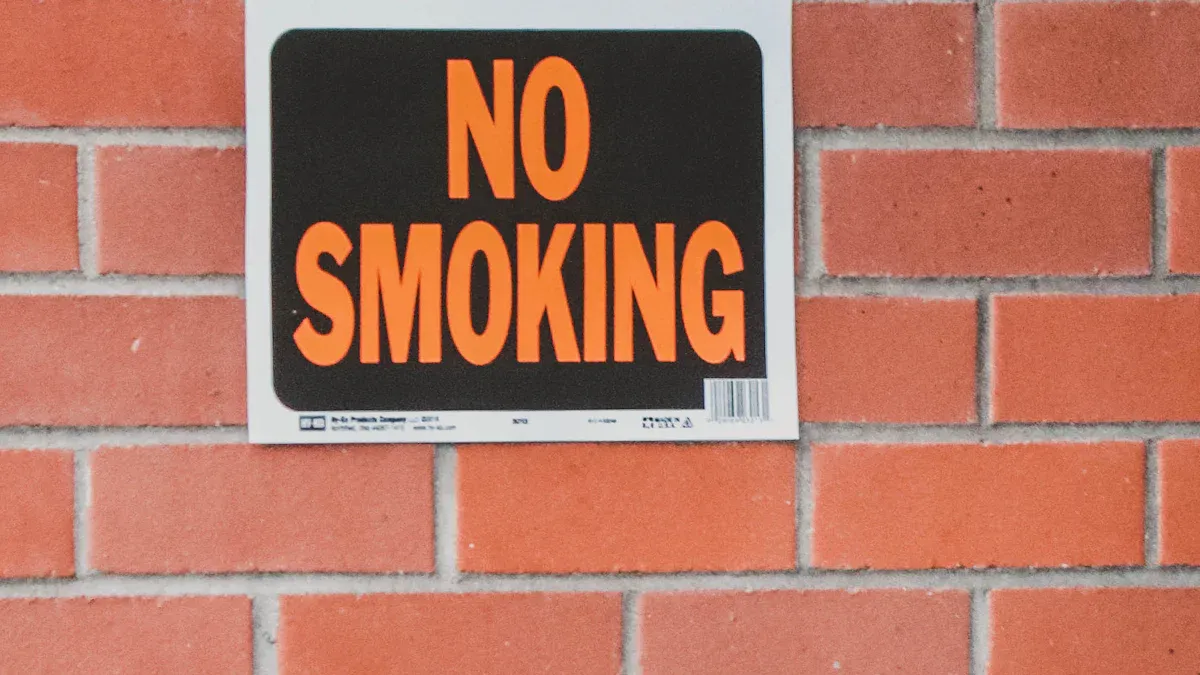Proven Tips to Quit Smoking for a Healthier Life

Quitting smoking transforms your life in ways you can’t imagine. Your body begins to heal, and your risk of diseases drops significantly. Nearly 70% of smokers want to quit, and many have tried. If you're looking for guidance, consider reading "How to Quit Smoking: Tips for a Healthier Lifestyle." Success is possible with determination and the right strategies. You hold the power to embrace a healthier lifestyle today.
Key Takeaways
Stopping smoking helps your health right away. Your heart rate slows, and your risk of sickness drops. Your body begins to fix itself quickly.
Having support makes quitting easier. Tell friends and family your plans. They can cheer you on and keep you motivated.
Find out what makes you want to smoke. Try healthier habits instead. Chew gum or take a walk when you feel like smoking.
Why Quit Smoking?

Health Benefits of Quitting
Quitting smoking transforms your health in remarkable ways. Your body begins to heal almost immediately. Within 20 minutes, your heart rate drops. Over time, your risk of developing smoking-related diseases decreases significantly. Smoking harms nearly every organ in your body, contributing to conditions like cancer, heart disease, and chronic lung diseases. In fact:
More than 16 million Americans live with diseases caused by smoking.
Smoking causes over 480,000 deaths annually in the U.S.
Quitting lowers your risk of early death and improves your overall health.
Health Benefit | Evidence |
|---|---|
Reduced risk of dying from smoking-related diseases | Studies show significant risk reduction after quitting. |
Improved survival rates post-lung cancer diagnosis | Quitting is linked to better survival outcomes. |
Enhanced surgical outcomes | Patients who quit before surgery heal faster and better. |
Similar long-term health outcomes to nonsmokers | Those who quit after a heart attack have comparable outcomes to nonsmokers. |
Financial and Lifestyle Advantages
Smoking doesn’t just harm your health—it drains your wallet. Imagine the money you could save by quitting. Many people use tools like the NHS Quit Smoking app to track their progress and savings. Seeing the amount of money saved becomes a powerful motivator. Beyond finances, quitting smoking improves your lifestyle. You’ll feel proud of your daily health achievements and enjoy a better quality of life.
Emotional Well-Being and Improved Relationships
Quitting smoking boosts your emotional well-being. You’ll experience lower levels of anxiety, depression, and stress. The mental health benefits of quitting can even rival those of antidepressants. As your mood improves, so do your relationships. Friends and family will notice the positive changes in your attitude and energy. Quitting smoking strengthens your connections with loved ones and helps you build a happier, smoke-free life.
How to Quit Smoking: Tips for a Healthier Lifestyle
Setting a Quit Date and Making a Plan
Choosing a quit date is a powerful first step toward a smoke-free life. Pick a specific day that holds meaning for you, such as a birthday or anniversary. Inform your family and friends about your decision. Their encouragement can boost your confidence. Before the big day, remove all smoking-related items from your home, car, and workplace. This includes cigarettes, lighters, and ashtrays.
Planning ahead increases your chances of success. Identify your smoking triggers and learn strategies to handle them. For example, if stress tempts you to smoke, practice deep breathing or take a short walk instead. Resources like BecomeAnEX® can help you prepare effectively. Discuss nicotine replacement options or medications with your healthcare provider. A clear plan, combined with support, sets you up for success.
Identifying and Avoiding Triggers
Understanding your triggers is key to quitting smoking. Common triggers include drinking coffee or alcohol, finishing a meal, or feeling stressed. Even boredom or sadness can make you crave a cigarette. Use a tobacco tracker tool to identify your personal triggers.
Once you know your triggers, develop healthier alternatives. Replace smoking with activities like chewing gum, sipping water, or doing a quick workout. Be patient with yourself. Quitting is a process, and every small victory counts.
Building a Strong Support System
A strong support system can triple your chances of quitting. Counseling and medication are highly effective. Online programs and community support also play a big role. Joining an online community connects you with others who understand your journey.
Reach out to your local stop-smoking service for expert guidance. Share your goals with loved ones. Their encouragement can keep you motivated. Remember, you’re not alone. With the right support, you can achieve a smoke-free lifestyle.
Effective Strategies to Quit Smoking
Using Nicotine Replacement Therapy (NRT)
Nicotine Replacement Therapy (NRT) can double your chances of quitting smoking. It works by giving your body a small, controlled dose of nicotine without the harmful chemicals found in cigarettes. Options like nicotine gum, patches, lozenges, and nasal sprays are available. Each method helps reduce withdrawal symptoms and cravings.
Studies show that varying doses and delivery methods of NRT can impact your success. For example:
Higher doses of nicotine patches may work better for heavy smokers.
Combining two forms of NRT, like a patch and gum, can improve results.
Talk to your healthcare provider to find the best option for you. NRT is a proven tool to help you on your journey to a smoke-free life.
Exploring Prescription Medications
Prescription medications offer another effective way to quit smoking. Medications like varenicline and bupropion target nicotine receptors in your brain. They reduce cravings and make smoking less enjoyable. Research shows that nicotine receptor partial agonists, such as varenicline, are highly effective for smoking cessation.
These medications are safe when used under medical supervision. Ask your doctor if prescription options are right for you. Combining them with other strategies, like counseling or NRT, can increase your chances of success.
Managing Stress and Anxiety Without Smoking
Stress often triggers the urge to smoke. Learning to manage stress in healthier ways can make quitting easier. Deep breathing exercises, meditation, and yoga are excellent tools to calm your mind. Physical activity, like walking or stretching, can also reduce stress and improve your mood.
Replace smoking with positive habits. When you feel stressed, try journaling or listening to music. These activities can help you relax without reaching for a cigarette. Over time, you’ll discover that you can handle stress without smoking.
Tip: Keep a list of stress-relief activities handy. Use it whenever you feel the urge to smoke.
Staying Active and Engaged
Staying busy can keep your mind off smoking. Physical activity not only distracts you but also boosts your mood and energy levels. Even simple activities like gardening, dancing, or taking a walk can make a big difference.
Hobbies and social activities can also help. Join a class, volunteer, or spend time with friends who support your smoke-free journey. Staying engaged reduces boredom, a common trigger for smoking.
By staying active, you’ll build a healthier lifestyle and strengthen your commitment to quitting. Remember, every step you take brings you closer to a smoke-free life.
Managing Cravings and Withdrawal Symptoms
Practicing Mindfulness and Relaxation
Mindfulness can help you overcome cravings by keeping your mind focused on the present moment. When you feel the urge to smoke, pause and take a few deep breaths. Close your eyes and concentrate on your breathing. This simple act can calm your mind and reduce stress. Meditation is another powerful tool. Even five minutes of quiet reflection can help you regain control over your thoughts and emotions.
Relaxation techniques like progressive muscle relaxation or guided imagery can also ease withdrawal symptoms. Imagine yourself in a peaceful place, such as a beach or forest. Picture the sights, sounds, and smells around you. These exercises can shift your focus away from cravings and toward a sense of calm.
Tip: Practice mindfulness daily, even when you’re not experiencing cravings. This habit strengthens your ability to stay smoke-free.
Finding Healthy Substitutes for Smoking
Replacing cigarettes with healthier alternatives can make quitting easier. Keep items like gum, hard candy, or carrot sticks within reach. These substitutes can satisfy the oral fixation that often accompanies smoking. Crunchy snacks like celery or apples can also keep your mouth busy while providing a refreshing distraction.
Drinking water or herbal tea can help, too. Sipping on a beverage gives your hands something to do and keeps you hydrated. Experiment with different substitutes to find what works best for you.
Reminder: Choose substitutes that align with your health goals. Avoid sugary snacks to maintain a balanced diet.
Keeping Your Hands and Mind Busy
Staying occupied is one of the best ways to combat cravings. Keep your hands busy with activities like doodling, knitting, or holding a stress ball. A pen or toothpick can also serve as a simple distraction.
Engage your mind with hobbies or tasks that require focus. Try solving puzzles, reading a book, or cooking a new recipe. Physical activities like taking a walk or gardening can also redirect your energy.
Here are some ideas to keep busy:
Take a relaxing bath or shower.
Practice relaxation techniques, such as deep breathing.
Keep substitutes like gum or hard candy nearby.
By staying active and engaged, you’ll find it easier to resist the urge to smoke. Every small effort brings you closer to a healthier, smoke-free life.
Staying Smoke-Free for the Long Term
Relapse Prevention Strategies
Staying smoke-free requires vigilance and preparation. Relapses can happen, but you can prevent them by staying aware of your triggers. Keep a journal to track situations or emotions that make you crave cigarettes. This helps you recognize patterns and avoid risky scenarios.
Create a list of coping strategies for moments when cravings strike. For example, take a brisk walk, call a supportive friend, or practice deep breathing. Keep reminders of your reasons for quitting, such as a photo of loved ones or a list of health benefits, in places you see daily.
Tip: If a relapse occurs, don’t be too hard on yourself. Treat it as a learning experience and recommit to your smoke-free journey.
Celebrating Milestones and Progress
Acknowledging your achievements keeps you motivated. Celebrate milestones like one week, one month, or one year smoke-free. Reward yourself with something meaningful, such as a small gift or a special outing.
Success stories from ex-smokers show that celebrating progress boosts confidence and reinforces commitment. For example, the Department of Health’s Tobacco Control Program highlights how recognizing milestones inspires others to quit smoking.
Milestone | Suggested Celebration Ideas |
|---|---|
1 Week Smoke-Free | Treat yourself to a favorite meal. |
1 Month Smoke-Free | Buy a book or hobby supplies. |
1 Year Smoke-Free | Plan a weekend getaway or larger reward. |
Creating a Smoke-Free Routine
A consistent routine helps you maintain a smoke-free lifestyle. Start your day with healthy habits like exercise or meditation. Replace smoking breaks with activities like stretching, journaling, or sipping herbal tea.
Keep your environment smoke-free by avoiding places where smoking is common. Surround yourself with people who support your decision to quit. Build new habits that align with your goals, such as cooking healthy meals or exploring new hobbies.
Reminder: A smoke-free routine strengthens your resolve and makes your new lifestyle feel natural.
Real-Life Success Stories

Inspiring Stories of People Who Quit
Hearing about others who have successfully quit smoking can inspire you to take the first step. Alicia, a former smoker for 21 years, describes quitting as one of her greatest accomplishments. She tried various methods but found success through self-determination and motivational resources. Her case manager introduced her to motivational videos, which helped her realize the importance of a healthier lifestyle.
You’re not alone in this journey. Many individuals have quit smoking with the support of family and loved ones. For example:
Tek Chanarin, 62, Cambodia: After quitting for four months, Tek credits his family’s encouragement for his success. He reflects on how quitting has transformed his life.
Ho Chung Ryu, 55, Republic of Korea: After smoking for 36 years, Ho decided to quit due to health concerns. Support from cessation services played a key role in his journey.
RT, 66, Philippines: RT began his quit journey during the COVID-19 pandemic. Fear of illness and his family’s support motivated him to stay smoke-free.
These stories show that determination, support, and the right resources can lead to success.
Lessons Learned from Their Journeys
Quitting smoking teaches valuable lessons. Many people discover that motivation and support are essential. Alicia’s journey highlights the power of self-determination and the impact of motivational tools. Others, like Tek and Ho, emphasize the importance of family and professional guidance.
Key Themes | Description |
|---|---|
Motivators for quitting | Health concerns, family support, and personal goals inspire change. |
Barriers to cessation | Stress, triggers, and lack of resources can make quitting challenging. |
Triggers for relapse | Emotional stress or social situations may lead to setbacks. |
By learning from these experiences, you can prepare for challenges and stay committed to a smoke-free life.
Quitting smoking transforms your life in countless ways. You improve your health, save money, and strengthen relationships. The journey may feel challenging, but success is within reach. Nearly 70% of smokers want to quit, and over 56% have tried. With the right strategies, you can join the 8.8% who successfully quit.
Statistic | Value |
|---|---|
Adults wanting to quit smoking | 67.7% |
Adults making a quit attempt | 53.3% |
Adults who successfully quit smoking | 8.8% |
Adults receiving advice from health professionals | 50.5% |
Adults using treatment to quit | 38.3% |

Take the first step today. Set your quit date, build a support system, and embrace a smoke-free routine. Every small victory brings you closer to a healthier, happier life. Remember, quitting smoking is not just a goal—it’s a journey worth taking. You’ve got this!
FAQ
What should I do if I relapse and smoke again?
Don’t give up! Relapse is part of the process for many. Reflect on what triggered it, adjust your plan, and recommit to your smoke-free journey. 💪
How long does it take to stop craving cigarettes?
Cravings usually peak within the first week and decrease over time. Staying busy and using strategies like mindfulness can help you manage them effectively.
Can I quit smoking without medication or therapy?
Yes, many people quit using willpower and lifestyle changes. However, combining methods like support groups or nicotine replacement therapy increases your chances of success.
Tip: Believe in yourself. Every step forward, no matter how small, brings you closer to a healthier, smoke-free life. 🌟
See Also
Join Us at Banish Cancer – A Place of Hope
An In-Depth Resource Covering Various Cancer Types
Exploring Bronchial Adenomas Alongside Carcinoid Tumors
